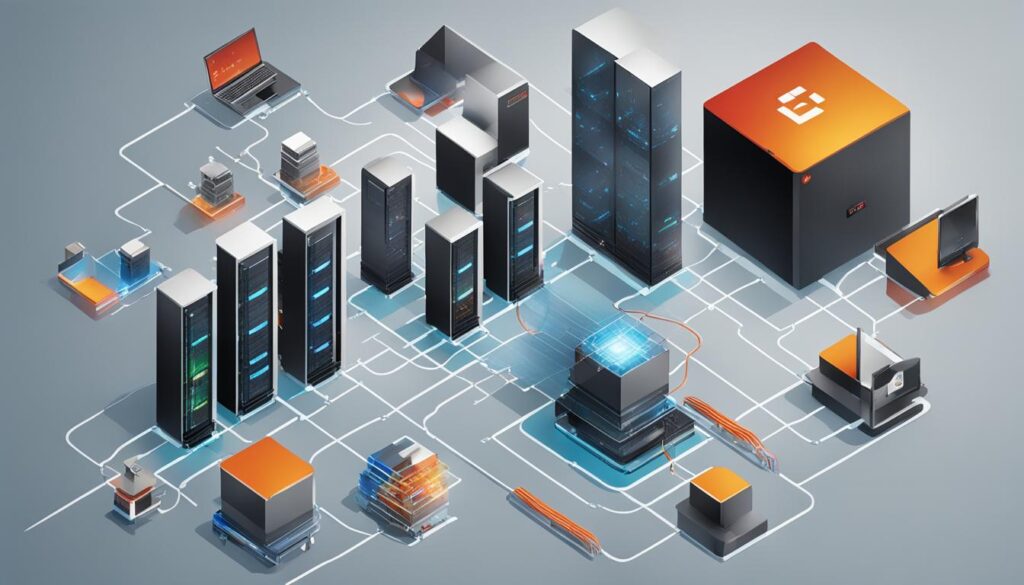Welcome to our guide on understanding networks in information technologies. In today’s interconnected world, networks play a pivotal role in enabling communication, sharing resources, and managing data efficiently. Whether you are a tech enthusiast or a business professional, it is essential to grasp the concept of networks and their significance in IT.
A network, in the context of information technologies, refers to a group of interconnected devices that exchange data and resources. It can be wired or wireless and serves as the foundation for transmitting, exchanging, and sharing information. Networks come in various types, each with its own features and functions.
Contents
Key Takeaways:
- A computer network is a group of interconnected devices that exchange data and resources.
- Networks can be wired or wireless and are used to transmit, exchange, and share information.
- There are different types of networks, such as LAN, WLAN, WAN, MAN, PAN, SAN, CAN, and VPN, each with its own features and functions.
- Networks facilitate various technologies and services like the internet, online commerce, social networks, and more.
- Understanding networks in information technologies is crucial for navigating the digital landscape and leveraging their power.
Types of Networks in Information Technologies
When it comes to information technologies, various types of networks serve different purposes. Understanding these networks can help you navigate the digital landscape more effectively. Let’s take a closer look at some of the key types of networks:
1. Local Area Network (LAN)
A Local Area Network, or LAN, is a network that connects devices within a limited geographical area such as an office building, school, or home. LANs are commonly used for sharing resources, such as printers and files, and enabling communication between devices.
2. Wireless Local Area Network (WLAN)
A Wireless Local Area Network, or WLAN, uses wireless technology to connect devices within a specific area, similar to a LAN. WLANs provide the flexibility of connecting devices without the need for physical cables, making them ideal for mobile devices and remote locations.
3. Wide Area Network (WAN)
A Wide Area Network, or WAN, spans a large geographical area and connects multiple LANs. WANs are commonly used to connect offices in different locations or to provide internet connectivity. The internet itself is a prime example of a WAN.
4. Metropolitan Area Network (MAN)
A Metropolitan Area Network, or MAN, is similar to a WAN but covers a smaller geographic area, such as a city or town. MANs are typically used to connect organizations or institutions within a specific locality.
5. Personal Area Network (PAN)
A Personal Area Network, or PAN, is a network that connects personal devices within a close range. PANs are commonly used for connecting peripherals like keyboards, mice, and headphones to a computer or for device-to-device communication, such as transferring files between smartphones.
6. Storage Area Network (SAN)
A Storage Area Network, or SAN, is a specialized network that provides access to consolidated, block-level data storage. SANs are commonly used in enterprise environments for efficient data sharing and storage management.
7. Campus Area Network (CAN)
A Campus Area Network, or CAN, is a network that connects multiple LANs within a campus or a specific area. CANs are commonly used in educational institutions or large organizations with multiple buildings.
8. Virtual Private Network (VPN)
A Virtual Private Network, or VPN, is a secure network that allows users to access private networks over a public network like the internet. VPNs provide encrypted connections, ensuring confidentiality and security for remote users.
Understanding the different types of networks in information technologies is essential for optimizing your network infrastructure and meeting specific business or personal needs. Each type offers unique features and benefits that cater to different use cases and requirements.
| Type of Network | Description |
|---|---|
| LAN | A network that connects devices within a limited geographical area. |
| WLAN | A wireless network that connects devices within a specific area, removing the need for physical cables. |
| WAN | A network that spans a large geographical area and connects multiple LANs. |
| MAN | A network that covers a smaller geographic area, such as a city or town. |
| PAN | A network that connects personal devices within close proximity. |
| SAN | A specialized network that provides centralized data storage and sharing. |
| CAN | A network that connects multiple LANs within a campus or specific area. |
| VPN | A secure network that allows users to access private networks over a public network. |
Components of a Network in IT
When it comes to building a network in information technologies, several components play a crucial role in ensuring its functionality and smooth operation. These components work together to create a robust and reliable network infrastructure that supports data transmission, resource sharing, and communication.
Routers
Routers are essential devices in a network that connect multiple networks together and enable data packets to travel between them. Acting as traffic directors, routers analyze the destination addresses of incoming data packets and determine the best path for them to reach their intended destinations. They also provide network security by implementing firewall rules and maintaining network address translation (NAT) tables to protect the internal network from external threats.
Switches
Switches are integral to facilitating communication within a network. They connect devices such as computers, printers, and servers, allowing them to share information seamlessly. Switches operate by examining the data packets’ destination MAC addresses and forwarding them to the appropriate destination devices. They provide dedicated bandwidth for each connected device, ensuring efficient data transfer and improving network performance.
Nodes
Nodes represent individual devices or workstations connected to a network. These can include computers, laptops, servers, printers, and other network-enabled devices. Each node has a unique network address, enabling it to send and receive data within the network. Nodes act as both endpoints for data transmission and recipients of network resources, leveraging the network infrastructure to access shared files, services, and applications.
Ports
Ports serve as connection points on networking devices, allowing various devices to be linked together. Ports can be physical, such as Ethernet ports on routers and switches, or virtual, such as TCP/IP ports used for network protocols. Each device has a specific number of ports that determine the number of simultaneous connections it can support. Network administrators use port configurations to manage traffic flow and control access to network resources.
Network Cable Types
Network cables are used to establish physical connections between devices in a network. The type of cable used depends on the network architecture and the transmission medium employed. Common network cable types include:
- Twisted Pair Cable: These cables consist of pairs of copper wires twisted together and are commonly used for Ethernet networks. They come in two categories: unshielded twisted pair (UTP) and shielded twisted pair (STP).
- Coaxial Cable: Coaxial cables have a central conductor surrounded by an insulating layer, a metallic shield, and an outer insulating layer. They are commonly used in cable television and broadband internet connections.
- Fiber Optic Cable: Fiber optic cables use strands of glass or plastic fibers to transmit data as pulses of light. They offer high-speed transmission, immunity to electromagnetic interference, and are ideal for long-distance communication.
Each network cable type has its own advantages and is suitable for different network requirements. The choice of cable type depends on factors such as bandwidth requirements, distance, and environmental conditions.
By understanding the components of a network in IT, including routers, switches, nodes, ports, and network cable types, you gain insight into how these elements work together to create a reliable and efficient network infrastructure. A well-designed network with the right components ensures seamless data transmission, resource sharing, and effective communication within your organization.

Importance and Role of Networks in Information Technologies
In the realm of information technologies, networks serve a critical purpose and play a significant role. They are the foundation upon which modern digital infrastructure is built, facilitating seamless communication, resource sharing, and efficient data management. Networks have become an indispensable part of our everyday lives, impacting individuals, businesses, and organizations in various ways.
One of the primary reasons for the importance of networks in information technologies is their ability to connect devices, systems, and people. Networks enable devices to communicate and share information, allowing individuals to access resources and services from remote locations. For example, the internet, which is the largest network in existence, provides access to a vast amount of information, services, and opportunities on a global scale.
Furthermore, networks play a crucial role in promoting collaboration and fostering innovation. They facilitate the exchange of ideas, knowledge, and expertise, enabling individuals and organizations to work together seamlessly, regardless of geographical distances. Through network connectivity, businesses can unlock new markets, establish partnerships, and drive innovation, leading to growth and competitive advantage.
Moreover, networks are essential for data storage, management, and security. Enterprises rely on network infrastructure to store and access critical information, ensuring its availability for business operations and decision-making. Networks also play a vital role in safeguarding data by implementing security measures such as firewalls, encryption, and access controls.
To illustrate the importance and role of networks in information technologies, here is a table summarizing key benefits:
| Benefits of Networks in Information Technologies |
|---|
| Facilitates seamless communication and resource sharing |
| Enables access to a vast array of information and services |
| Promotes collaboration, innovation, and partnerships |
| Supports efficient data storage, management, and security |
By understanding the importance and role of networks in information technologies, individuals and organizations can harness their power to drive growth, enhance productivity, and stay competitive in the digital age.

The Power of Connectivity
Networks enable individuals and businesses to connect and communicate seamlessly. Whether it’s a local area network (LAN) within an office building or a wide area network (WAN) connecting continents, networks bridge geographical distances and provide instant access to resources and services. This connectivity has revolutionized the way we live, work, and interact, opening up new possibilities and transforming industries.
Conclusion
Networks serve as the backbone of information technologies, allowing for seamless communication, efficient resource sharing, and effective data management. Understanding the different types of networks, their components, and their roles is essential in navigating the digital landscape and harnessing the power of networks for both personal and organizational purposes.
Whether it’s a Local Area Network (LAN) connecting computers within an office building or the vast expanse of the internet connecting billions of devices worldwide, networks are fundamental in today’s interconnected world. They provide the infrastructure for various technologies and services, enabling online commerce, social networking, and global connectivity.
By leveraging the power of networks, businesses, individuals, and organizations can thrive in the digital age. Networks facilitate collaboration, streamline workflows, and enhance productivity. They enable secure and fast access to shared resources, allowing for seamless information exchange and storage. With networks, organizations can expand their reach, connect with customers, and create new opportunities in a globally connected marketplace.
In conclusion, networks are an integral part of information technologies. Their vital role in enabling communication, resource sharing, and efficient data management cannot be overstated. As technology continues to advance, understanding and harnessing the power of networks will be paramount for success in the ever-evolving digital landscape.
FAQ
What is a network in information technologies?
In information technologies, a network is a group of interconnected devices that exchange data and resources. It can be wired or wireless and is used to transmit, exchange, and share information.
What are the types of networks in information technologies?
The types of networks in information technologies include LAN, WLAN, WAN, MAN, PAN, SAN, CAN, and VPN.
What are the components of a network in IT?
The components of a network in IT include routers, switches, nodes, ports, and different types of network cables.
What is the importance of networks in information technologies?
Networks play a crucial role in information technologies by enabling communication, resource sharing, and efficient data management. They are essential for various technologies and services like the internet, online commerce, social networks, and more.
What is the role of networks in IT?
Networks form the backbone of information technologies, providing access to shared resources, facilitating communication, and enabling data storage and sharing. They are crucial for navigating the digital landscape and leveraging the power of networks for organizational and personal purposes.




